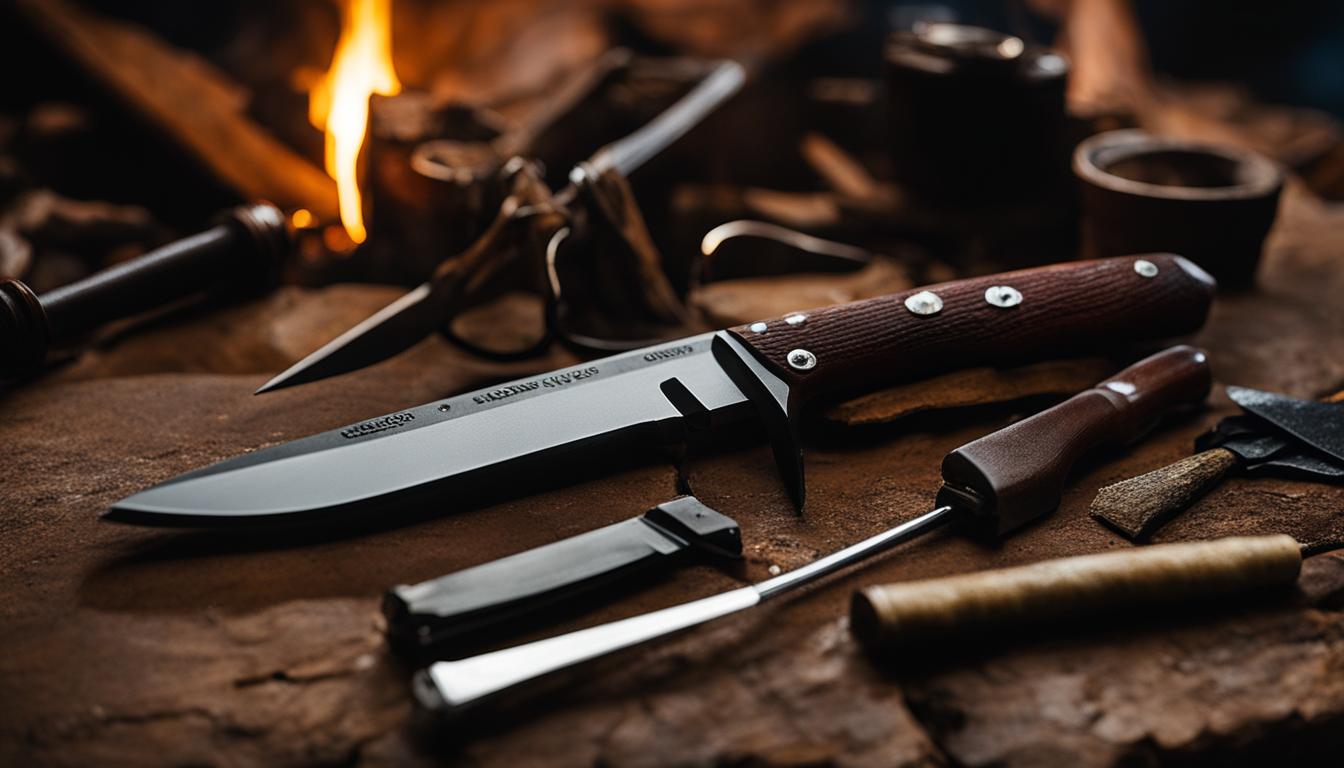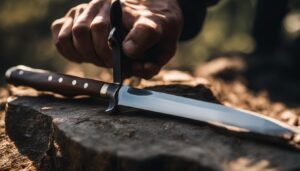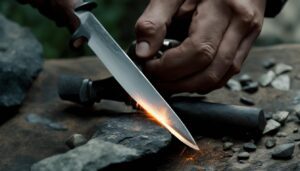As a hunting enthusiast, I know the importance of keeping my blades in top-notch condition for a successful outdoor adventure. That’s why I’ve compiled a list of the top 10 knife maintenance hacks that will help you ensure your hunting blades are always sharp, efficient, and ready for action.
With these knife upkeep tips, you’ll be able to maintain the longevity and functionality of your hunting knives, allowing you to make precise cuts and handle any task with ease. From cleaning and lubricating to proper storage techniques, these hacks will become essential practices in your knife care routine.
Key Takeaways:
- Regularly clean your hunting knives after each use to remove debris and prevent rust buildup.
- Invest in high-quality knife lubricants, such as gun oil or Rem oil, to ensure smooth operation.
- Recognize signs of trouble, such as misfiring or sluggishness, that indicate the need for maintenance.
- Use essential knife cleaning tools, like a precision screwdriver, to disassemble and reassemble your blades.
- Properly store your hunting knives in a carrying pouch to protect them from dust and moisture.
By implementing these knife maintenance hacks, you’ll extend the lifespan of your hunting blades and enhance their overall performance. So, let’s dive into the world of knife care and ensure that your hunting adventures are always sharp and successful!
Benefits of Double Action Knives for Hunting
Double action knives, also known as out-the-front (OTF) knives, offer numerous benefits for hunting enthusiasts. These knives have become increasingly popular due to their unique features and versatility, making them a valuable addition to any hunting blade collection. In this section, we will explore the advantages of using double action knives for hunting and why they are favored by many outdoor enthusiasts.
Single-Button Deployment: One of the key advantages of double action knives is their single-button deployment mechanism. With a simple push of a button, the blade swiftly deploys, allowing for quick and easy access during hunting situations. This feature is particularly useful when you need to react swiftly to unexpected encounters or when time is of the essence.
Versatility for Outdoor Activities and DIY Work: Double action knives are not only suitable for hunting, but they also excel in various outdoor activities. Their robust construction and durability make them ideal for tasks such as camping, fishing, and hiking. Additionally, their ease of use and practicality extend to indoor DIY projects, making them a versatile tool for everyday use.
Overall Functionality: Double action knives are designed with functionality in mind. Their sleek and ergonomic designs offer excellent grip and control, ensuring optimal performance in various hunting scenarios. These knives often feature high-quality blades that retain sharpness and durability even after extended use, providing reliable cutting power when you need it most.
To fully appreciate the benefits of double action knives for hunting, it is essential to understand their unique features and how they enhance performance in outdoor activities. Whether you are a seasoned hunter or a novice, investing in a double action knife can greatly enhance your hunting experience and provide you with a reliable tool that can withstand the demands of the great outdoors.
Essential Knife Cleaning Tools for Maintenance
Proper maintenance of hunting knives is crucial for their longevity and performance. To effectively clean and maintain your knife, you’ll need a few essential tools:
- Knife lubricant: A high-quality knife lubricant is essential for keeping your blade functioning smoothly. Consider using gun oil, Rem oil, or WD-40 to protect against rust and reduce friction.
- Clean soft rag: A clean, soft rag is ideal for removing debris and excess lubricant from your knife. Use it to wipe down the blade after each use and to ensure it stays clean and dry.
- Precision screwdriver: A precision screwdriver comes in handy for disassembling and reassembling your knife. This tool allows you to easily access and clean hard-to-reach areas, ensuring thorough maintenance.
By having these tools on hand, you’ll be well-equipped to keep your hunting knife in optimal condition, ready for your next outdoor adventure.
Best Practices for Cleaning and Maintenance
Proper cleaning and maintenance are crucial for ensuring the longevity and optimal performance of your hunting knife. By following these best practices, you can keep your knife in top condition for your outdoor adventures.
1. Clean Your Knife Often
The first step in maintaining your hunting knife is to clean it regularly, especially after each use. Use warm soapy water and a soft cloth to remove any dirt, debris, or residue from the blade and handle. Make sure to dry the knife thoroughly to prevent moisture buildup, which can lead to rust and corrosion.
2. Recognize Signs of Trouble
It’s essential to be vigilant and recognize any signs of trouble that may indicate the need for maintenance. If you notice your knife misfiring, becoming sluggish, or experiencing residue clogging, it’s time to give it some care. These issues can affect the functionality of your knife and compromise your safety in the field.
3. Practice In-Between Cleaning
In addition to regular cleaning, perform in-between cleaning to keep your knife in excellent condition. Use compressed air to remove loose debris from hard-to-reach areas, such as the pivot point and handle grooves. For sticky residue, use rubbing alcohol and a Q-tip to gently remove it without damaging the blade or handle.
“Regular cleaning and proper maintenance are essential for keeping your hunting knife sharp and reliable. By adhering to these best practices, you can ensure the longevity of your knife and maximize its performance when you need it most.”
4. Lubricate and Protect
After cleaning, apply a thin coat of knife lubricant or oil to the blade, pivot point, and other moving parts. This will protect the knife from moisture, rust, and friction, ensuring smoother operation and preventing wear and tear. Choose a high-quality knife lubricant that is specifically designed for this purpose.
| Common Signs of Trouble | Possible Causes | Solutions |
|---|---|---|
| Knife misfiring | Buildup of debris or residue, worn or dirty spring | Clean the knife thoroughly, replace or clean the spring |
| Sluggish knife | Lack of lubrication, dirt or debris in the pivot area | Apply knife lubricant, clean and lubricate the pivot area |
| Residue clogging | Adhesive residue from tape or stickers | Use rubbing alcohol and a Q-tip to remove the residue |
By following these best practices for cleaning and maintenance, you can ensure that your hunting knife remains in top-notch condition for years to come. Regular cleaning, recognizing signs of trouble, practicing in-between cleaning, and proper lubrication are all key steps to keep your knife sharp, reliable, and ready for your next hunting expedition.

Proper Storage and Reassembly Techniques
Proper storage is essential for maintaining the longevity and functionality of your hunting knife. By following simple storage practices, you can prevent clogging and rusting, ensuring your knife is always ready for use. One effective method is to use a carrying pouch specifically designed for knives. These pouches provide a protective barrier against dust, moisture, and other potential contaminants that could damage your blade. Keep your knife stored securely in a pouch when not in use to prevent unnecessary wear and tear.
When it comes to reassembling your knife after disassembly for cleaning or maintenance, it’s crucial to follow the correct techniques to avoid any potential issues. Begin by arranging the various components of your knife, ensuring all parts are clean and free of debris. Take your time to carefully align each piece, ensuring a proper fit. Refer to the manufacturer’s instructions for any specific reassembly steps unique to your knife model. By following these steps diligently, you can ensure a successful, hassle-free reassembly process.
In conclusion, proper storage and reassembly techniques play a vital role in maintaining the overall condition and performance of your hunting knife. Investing in a suitable carrying pouch and following the manufacturer’s guidelines for reassembly will protect your knife from potential damage and ensure it remains in optimal working condition for years to come.


| Benefits of Proper Storage and Reassembly Techniques |
|---|
| Prevents clogging and rusting |
| Protects the knife from dust and moisture |
| Ensures hassle-free knife reassembly process |
| Extends the lifespan of the knife |
| Maintains optimal performance |
Conclusion
Throughout this article, I have shared with you the top 10 knife maintenance hacks that every hunting enthusiast should know. By implementing these blade care tricks and cutlery maintenance pointers, you can ensure that your hunting knives stay in optimal condition and perform at their best.
Proper knife maintenance is essential for extending the lifespan of your blades and maximizing their functionality. Regularly cleaning your knife after each use, coating the blade with lubricant to prevent buildup and rust, and recognizing signs of trouble are all crucial steps in maintaining your hunting knives.
Additionally, by using the right cleaning tools and following best practices for maintenance, you can keep your knives sharp and efficient. Remember to store your knives properly, using a carrying pouch to prevent clogging and rusting, and reassemble double-action knives correctly after disassembly.
By prioritizing knife maintenance and incorporating these hacks into your routine, you can ensure that your hunting knives are always ready for action. So, take care of your blades, and they will take care of you during your hunting activities.
FAQ
What are some essential maintenance hacks for hunting knives?
Some essential maintenance hacks for hunting knives include regularly cleaning the knife after each use, coating the blade with lubricant to prevent buildup and rust, and recognizing signs of trouble that indicate the need for maintenance.
Why are double action knives ideal for hunting?
Double action knives, specifically out-the-front (OTF) knives, offer unique features such as single-button deployment, versatility for outdoor activities and do-it-yourself work, and overall functionality, making them ideal for hunting.
What tools are essential for knife cleaning?
Essential knife cleaning tools include a high-quality knife lubricant (such as gun oil, Rem oil, or WD-40), a clean soft rag for debris removal, and a precision screwdriver for disassembly and reassembly.
What are the best practices for cleaning and maintaining hunting knives?
Best practices for cleaning and maintaining hunting knives include regularly cleaning the knife after each use, coating the blade with lubricant, using compressed air to remove loose debris, and removing adhesive backing with rubbing alcohol and a Q-tip.
How should hunting knives be stored to prevent clogging and rusting?
Hunting knives should be stored in a carrying pouch when carrying them every day and covered to protect them from dust and moisture. Additionally, proper reassembly techniques for double-action knives should be followed to ensure easy storage.





